Types of plants in landscaping flat shrub. What deciduous trees and shrubs are most suitable for landscape composition
noticeably transformed country houses, cottages, dachas. The territories, until recently allotted for vegetable gardens, are now replaced by flower beds, lawns, and lawns. Landscape composition gives a unique charm to homeownership and creates comfort. A special place in the modern exterior began to be occupied by coniferous trees, most of which have recently appeared in our country.
Basic Design Rules
Creating an original and unique exterior is not only a decoration of the site. Landscape composition is a whole art. To make your site look harmonious, you need to consider two main aspects:
- biological;
- engineering.
In other words, all beds, plantations, flower beds should be skillfully combined with other buildings. Stick to a consistent style.
Create compositions in landscape design It's easy if you follow a few tips:
- Prepare the area. Think over and draw up a plan, placing all the elements on it: a house, trees, a bathhouse, shrubs, flower beds.
- Grouped plants look more profitable than planted in a single version. But combine only those that do not interfere with each other's growth.
- Try to avoid straight, strict lines in landscape design. Orderliness is wonderful. But strict observance of symmetry will deprive the site of naturalness.
- Initially, think over the additional components of your landscape design. These can be decorative elements (fountain, pond), original artistic details (paths, lamps).
Determine the balance you have chosen as the basis for building a landscape composition. If you decide to stick to symmetry, then you need to repeat the main elements in a mirror image. It can be flowerpots with flowers on both sides of the path.
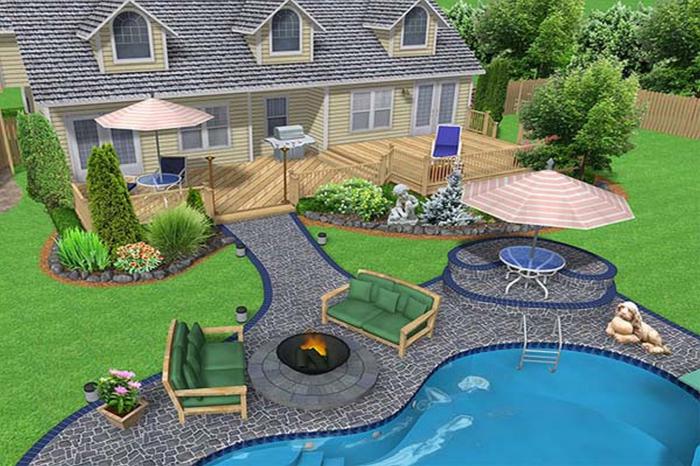
When choosing an asymmetric balance, the unity of the composition is assumed in relation to one subject.
Creating a beautiful design
Significantly help to create beautiful landscape compositions of the scheme. You can use the ready-made proposals of designers. But some owners prefer to develop such schemes on their own.
To make your country design look gorgeous and pleasing to the eye, follow these tips:
- The suburban area should be the unity of space. This effect is easily achieved by repeating the main elements in different parts of the garden. The desired result can be achieved with a single color palette.
- A simple landscape composition looks harmonious and natural. Beautiful design will create smooth transitions from one element to another.
- Trees are planted according to their height. Start low and work your way up to high. This will create a depth effect in your area. In addition, visually your household will appear much larger.
- Observe proportionality. Too bulky objects should not be placed in a small space. And over a large area, small details will look somewhat out of harmony.
Deciduous plants
Beautiful landscape compositions must necessarily include various elements.
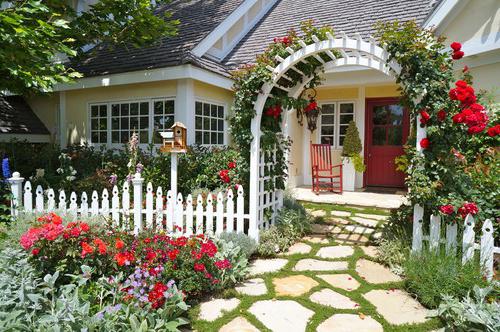
Deciduous plants in the summer will give a lot of green colors. In addition, they will emphasize the movement of time in your garden. In winter, when the leaves fall from the trees, the dark trunk will contrast perfectly with the snow-white snow. In autumn, your garden will be enriched with scarlet and gold colors.
Coniferous trees
They keep their green all year round. This should definitely be used. It is landscape compositions from coniferous trees create a wide scope for creativity. These plants look great in winter. In addition, they are very unpretentious.
evergreens
This is an original way to create an exclusive design option. Deciduous evergreens - holly, boxwood enjoy great polarity. They allow you to build a wide variety of fences. Topiaries can be formed from them - certain sculptures that are formed due to a curly haircut.
The combination of coniferous and deciduous plants in one composition
Such ready-made landscape compositions always look the most advantageous. But, unfortunately, not all plants get along well with each other. Therefore, combining various representatives of the plant world, their biological characteristics should be taken into account.
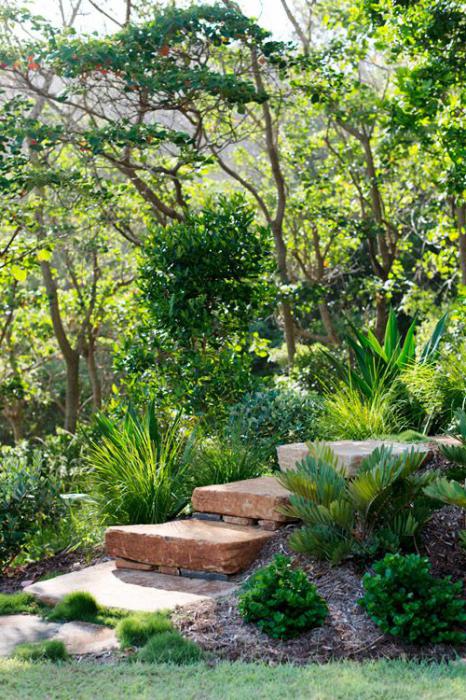
Some are able to get sick with "rust". Such an attack can spread to other plants. Often sick shrubs should not be placed near either. Because the risk of infection is high.
Shrub placement
Landscape composition implies not only the presence of flowering plants. Shrubs and trees are very important in garden design. But you need to position them correctly. This will give the semantic completeness of the composition.
Shrubs are often placed along the perimeter, marking the boundaries of rockeries, rock gardens. Sometimes they create landscape compositions from shrubs. In this case, they are the accents of the site. Plants and flowers are planted around them.
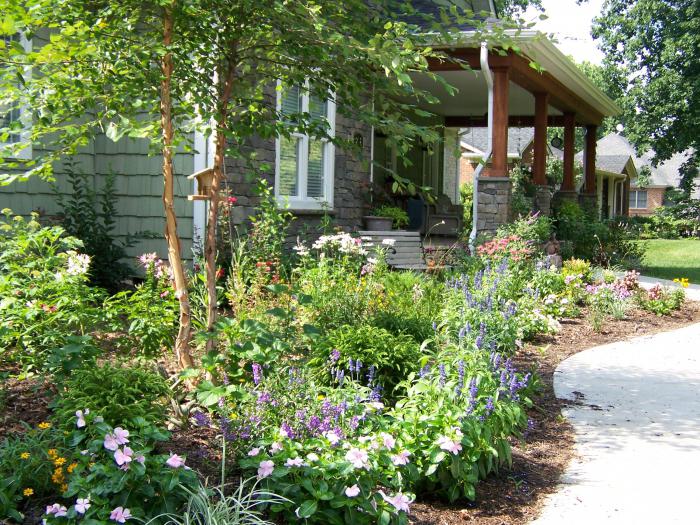
Types of landscape compositions
So, if you are looking to create a beautiful, well-groomed garden, pay attention to coniferous plants. They have a charming look, exquisite shapes and allow you to embody the most daring design solutions in almost any area.
Ready-made landscape compositions, in which deciduous and coniferous plants are harmoniously combined, always look perfect.

Now let's look at how to make such a design:
- Pines, cypresses, spruces, junipers, thujas, firs are evergreens that look good in the very center of your backyard. In this case, they form coniferous sculptures. They can be placed on the border of the site.
- picturesquely combined with roses, heather, rhododendrons, deciduous plants. Such details will bring some contrast and brightness to the design. They perfectly modify the design of the garden seasonally. Try to avoid birches and bird cherry trees. These trees have a rather negative effect on needles.
- Ready-made landscape compositions of pyramidal coniferous trees look great. If you have even a little creativity, you can make great ones out of them. geometric figures, tiers, columns, spirals, intricate alleys. Curly trimmed trees can divide the space into certain areas. Such details perfectly decorate small ponds, stone slides. They look great on the differences in relief, colorfully complement rock gardens.
- Do not forget that your landscaping of coniferous vegetation should delight with volumetric structures and its coloristic pictures at any time. Therefore, when creating a composition, combine various shapes, textures and colors of coniferous trees.
- Landscape design must include accent trees and shrubs. Experts advise choosing winter-hardy varieties. They will delight with their stability all year round. For the background, vegetation with a spreading crown is more suitable. Weaving low-growing plants should complete the composition.
- When placing shrubs and trees, try to emphasize the lines of the site. Plant them in areas where appearance, the original form will only add refinement to the relief. They should perfectly emphasize the contours of structures and structures on the landscape, match the configuration of paths and other objects. Trees and shrubs look great when placed near the entrance to the house.
- Tall vegetation is harmoniously combined, located near the garden stairs and retaining walls. In this case, shrubs and trees become an excellent addition to landscape design.
- An excellent place for planting vegetation are the bends of paths and forks. Often trees are placed near recreation areas and gazebos. In this case, not only an aesthetic goal is pursued, but the necessary shadow is created in the hot season.
- A wonderful option, according to the designers, is the placement of shrubs and trees in flower beds. You can plant them next to flower beds.
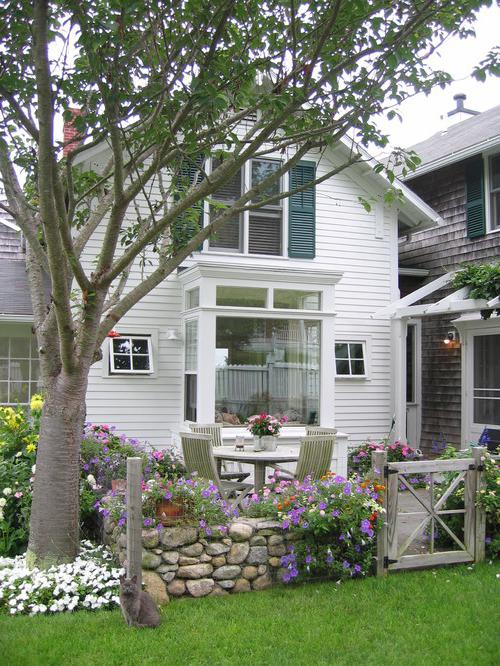
Conclusion
Not a single beautiful garden plot can do without decorations created by the caring hands of the owners in the form of landscape compositions. Decorative design can be made up of coniferous and deciduous plants, shrubs. But the most attractive and harmonious option is their correct combination.
Before grabbing a shovel and developing a new bed, let's deal with the definition of what a mixborder is - this is an indispensable element of European landscape design and a relatively new type of complex flower garden of continuous flowering. If you choose the right plants and properly care for them, beautiful mixborders remain so throughout the year. You can improve the art of creating a mixborder flower garden indefinitely, but it’s better to start with the simplest and most affordable schemes.
Mixborder - do-it-yourself flower garden
Almost everyone can learn the art of combining plants. For example, after reading this article, every second reader will be able to create with his own hands (without the help of landscape designers) such a complex element of garden design as a mixborder.
Let's say right away that caring for such a flower garden, which is most often decorated with perennial and annual plants, cereals and potted flowers, ornamental shrubs and even small coniferous trees, it is extremely difficult. To provide different types plants the most correct care, systematic supervision is necessary:
- timely transplant;
- cultivation;
- watering;
- pruning;
- fertilizer and disease prevention.
And if you are not afraid of the upcoming difficulties, and you dream of making your garden or cottage even more picturesque through mixborders, then it's time to get acquainted with the most important rules for creating continuous flowering mixborders.
Creating a mixborder - where to start?
A mixborder in a garden differs from a border and a border in that the flowers in it are placed in free dense groups that smoothly flow into each other. At the same time, in any mixborder there should be plants that will create a “winter effect”, set the height and shape of the fragrant island. In landscape design, they are called "skeletal" or the main islands of the composition.
Having prepared the soil and dividing the site into three unequal parts, first (in the background of the frontal mixborder) voluminous plants with leaves of interesting shapes are planted. The next row is reserved for tall flowers with straight stems. Then place medium-sized plants without lush foliage. Next, low, ground cover plants are planted, and already behind them - annuals.
Such a tiered placement is done in order to "mask" the elongated stems of flowers of the middle plan.
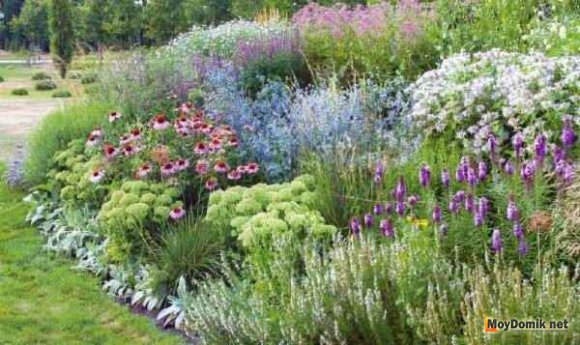
Choosing a place for a mixborder
Flower gardens of free outlines (as gardeners also call mixborders) are located in open sunny areas or (if these are “woody mixborders”) in slightly shaded places.
Coniferous heather perennial compositions, made up of a mixture of various plants: heathers, eric, rhododendrons and dwarf coniferous varieties, look especially impressive along a hedge, a small hill, a house facade or on the edge of a terrace.

The "English mixborder", which is based on garden and wild perennials, is most often placed against the background of the lawn, parallel to the paths leading to the buildings, along the walls of the house. A mixborder along a fence or fence will emphasize and complete the composition of the landscape design of the site.
Prefabricated compositions or "combined mixborders" are broken up over large areas. The length of such an elongated flower garden is practically unlimited - it can occupy the entire perimeter of the site or only its inner part. At the same time, part of the flower garden is in the open sun, part in partial shade and part in the shade.
Organically next to a country house or a luxurious cottage look "shrub mixborders" - compositions collected from flowering and decorative leafy shrubs.
And if the “shrub mixborder” is a relatively new element, then the “seasonal” is a long-proven option for a garden still under construction, where planting perennials irrational.
You can beautifully complement the composition of a shady garden with a decorative leafy flower strip formed from shade-tolerant shrubs and flowers.
Regardless of location, mixborders must be planted in rows. At the same time, low participants in the plant composition (up to 40 cm) are planted in the foreground, medium (up to 60 cm) and high (100 cm or more) - in the back.
Plants for the mixborder
The words that came to us from foggy Albion "mix" (from English mix) and "border" (from English border, border) have become an integral part of gardens in any style. And at the same time, only at first glance it seems that the plants on the mixborder are planted randomly. Of course it isn't. But many novice amateur gardeners, knowing little about the compatibility of plants and their exactingness, are planted next to everyone. As a result, instead of a picturesque strip, something neglected and sloppy appears.
For example, you should not plant in a mixed mixborder with a very high planting density fast-growing perennial plants with creeping rhizomes (for example, Ludovik's wormwood). Yes, they really suppress the growth of annoying weeds, but the growth of some capricious plants, such as lily of the valley and other bulbs, is extremely negatively affected.
That is, ready-made mixborders, which we most often see in colorful pictures, are both an exciting and incredibly difficult project, the success of which entirely depends on the right choice of plants.
Do-it-yourself step-by-step design of mixborders from perennials, conifers and shrubs
A mixborder flower garden in a country house garden will attract attention from early spring until October-November, if the plants are selected so that one, blooming, replaces the other. At the same time, green foliage will play an important role in the design of this kind of flower garden, which, during the flowering period of certain species, will not allow the mixborder to lose its splendor and decorativeness.
Mixborder scheme 1 - perennial flower garden
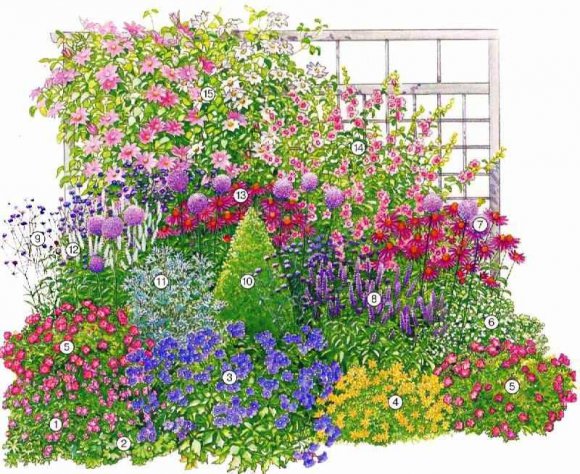
In this mixborder example, the bottom row contains:
No. 5 "Potentilla shrub". Potentilla blooms from July to August. In autumn, the plant is dressed in a bewitching golden "dress". And in winter, its reddish branches stand out noticeably against the white snow.
No. 4 "Coreopsis whorled".Short plant blooms for a long time and abundantly. From the end of June until the very frost, coreopsis pleases with yellow flowers with a different shade: purple, pink or brown.
No. 3 "Geranium majestic". Bush blooms in July 30-40 days. Brick-red or yellow-orange geranium acquires in autumn.
No. 2 "Cuff soft". This perennial herbaceous plant blooms with small yellow flowers, similar to clouds, from June to July. But gardeners plant the cuff in a perennial mixborder not because of its cute inflorescences, but for its luxurious leaves with a wavy edge.
№1 "Geranium Endressa". Blooms profusely all summer. In late autumn and winter, it decorates the flower garden with dark green, palmate leaves. The frost-resistant spherical bush is not afraid of the temperature even at -40C.
The middle row contains the following flowers for the mixborder:
No. 5 "Potentilla shrub"(in this mixborder scheme, it is located on the right in the bottom row and on the left in the middle row).
No. 6 "Yarrow ptarmic". The flowering of this perennial plant occurs in July and lasts until the end of summer.
No. 7 "Decorative bow". A plant of wondrous beauty is often included by landscape designers in perennial mixborders. And that's why. The fact is that a decorative bow brings a certain charm to any flower combination of a mixborder. Even fading on the first day of summer (the main flowering occurs in May-June), dried balls of inflorescences delight the garden until late autumn.
No. 8 "Multi-grate fennel". A plant with a corolla color from lilac to dark purple reaches a height of 1 m. It blooms from July to August.
No. 9 "Verbena Bonarskaya". Elegant vervain, studded with small purple stars, easily fits into any flower garden, even in such difficult to arrange as a mixborder with roses. The resistant plant blooms from June until hard frosts.
No. 10 "Boxwood". This slow growing shrub is not particularly difficult to care for. It is valued not for its small flowering, which is rare but occurs in early spring, but for its showy evergreen crown.
No. 11 "Decorative wormwood". The filigree, lacy leaves of this deciduous plant make it unlike any other horticultural crop. Against its background, the most common wild flower seems mysterious.
In the background of the described mixborder scheme, they land:
Note that this mixborder is best placed along the fence or wall of the house.
No. 12 Lofant. The versatility of this plant lies in the ability to bloom from July until late autumn. The bush grows quickly and looks incredibly impressive in the background of the mixborder.
No. 13 "Echinacea purpurea". A beautiful flower with bright petals has a completely unattractive foliage. Therefore, echinacea is always placed between other plants to create the illusion of lushness. flowering shrub.
No. 14 "Hatma". The shrub, which sometimes reaches two meters in height, blooms profusely from July until the first frost.
No. 15 Clematis. Velvet delicate flowers of white, pink, blue and red colors delight the eye from early spring to late autumn. Their amazing flowering can only be interrupted by persistent frosts.
You can enhance the decorative effect of a tiered flower garden if perennials are planted in groups, as in the detailed mixborder diagram below:

It is very important that the group of plants with which you are going to decorate the mixborder have similar needs: requirements for soil acidity and its fertility, moisture supply and light level. So, all the flowers in the diagram above grow well in full sun and in rare shade. They are not too capricious in care, which means that they can be fed and watered in a complex.
Mixborder design in the garden - all shades of mood
Even the most beautiful flowers that are dissonant in color can create havoc in a flower arrangement and completely destroy it. A color scheme, carefully and well thought out, is important for any flower garden, and especially for a complex mixborder.
An indelible impression is made by a flower garden built on contrasts. It seems incredibly bright and sets the rhythm for the entire backyard. For example, combinations of purple and canary yellow, rich green and red, sky blue and orange create impressive contrasts. At the same time, planting plants of contrasting shades is not randomly worth it. Visually, the colors will blend and become muddy. The best option- choose plants with large flowers as accent plants and plant small-flowered individuals of a different color in small spots among them.
The monochrome mixborder looks elegant and deep (the photo of which is presented below). It relaxes and adds neatness to the whole garden. The ideal monochrome in a flower garden is three colors, with smooth transitions from one color range to another. For revitalization, plants with white flowers are often included in a monochrome composition.
The material was prepared for the site www.site
Decoration of a monochrome blue-blue flower garden

No. 1 "Small stamen geranium". Large bushes of this catchy and very bright plant, flower beds are decorated most often. And that's why. Geranium can grow without a transplant for more than 10 years. Blooms from mid-June to August.
No. 2 Anhuza Dropmore. A beautiful plant with blue and sky blue flowers blooms in May and adorns the mixborder through July-August.
No. 3 "Lupin multi-leaved". A completely trouble free plant. The first time blooms in May, followed by the second and third wave of flowering.
№4 "Delphinium "Blue Bird". This charming perennial is easy to grow even for a beginner gardener. Large semi-double flowers first appear at the beginning of summer, the second - at the end.
№5 "Hibiscus Syrian". He does not like the shade and pleases with lush flowering from June to October only with a sufficient amount of ultraviolet light.
No. 6 "Katovnik". Lush blue brushes of catnip adorn the garden all summer.
No. 7 "Mordovnik". The flowering period of blue-blue flowers falls on June, July. He loves the sun, but is also frost-resistant.
№8 "Delphinium "Blue Lace". Magnificent flowers raise their inflorescences high (up to 2 m), charming everyone around.
No. 9 "Veronica long-leaved". Small, blue flowers with white spots appear on the plant in July, and adorn the mixborder until the first frost.
No. 10 "Veronica". A fragile and delicate flower seems only at first glance. In fact, he easily tolerates the sun, and drought, and shade. Blooms from May to late summer.
No. 11 "Iris". An unusually beautiful flower is simply created for garden accents. Flowering lasts about a month in June-July.
No. 12 "Linen". Blooming flax looks like a sky blue carpet. New buds of a sky blue plant appear for three months - from June to September.
Mixborder of conifers and shrubs - additional elements
Including additional decorative elements in the design of the mixborder, which itself is incredibly bright and self-sufficient, you need to be especially careful. The lack of a sense of taste and proportion can lead to the fact that a beautiful mixborder turns into a ridiculous exhibition of mushrooms and gnomes.
To prevent this from happening, landscape designers recommend adding large stones to a large mixborder with conifers and shrubs, as if by chance. Cobblestones do not need to be laid out in a straight line. It is better if the boulders randomly peek out from under the plants.
If it is planned to design a double-sided wide mixborder at the dacha, then inside it you can think of slightly noticeable paths from large flat stones or tiles.

Shrub mixborder - ready-made schemes
Large and dwarf shrubs in the mixborder provide consistency and define the structure of the flower garden. With proper pruning, shrubby plants can grow for years without requiring much attention.
So the most popular shrubs that bloom at different times of the year include: forzatsia, mountain ash, viburnum, canadian irga, rhododendron, camellia, magnolia, hydrangea, barberry, red-root, chaenomeles and others. It pleases with beautiful leaves: holly, narrow-leaved sucker, noble laurel, boxwood, holly, pieris, mahonia and many others.
By adding conifers and a few lush, large perennials to the shrubs, we get a mixed mixborder.
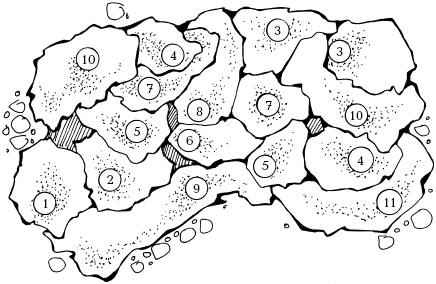
No. 1 "Spruce dwarf cushion". The decorativeness of the needles and the compact size of this coniferous shrub make it an incredibly popular element in garden landscaping. (1 PC.)
No. 2 "Asters and Tulips". By picking up plants from different classes and groups, you can get colorful compositions that bloom from mid-spring to summer. (60 pcs.)
No. 3 "Byzantine Cleaner". An unpretentious and charming plant with fluffy leaves blooms all summer and often becomes an adornment of mixed plantings. (7 pcs.)
No. 4 "Phloxes". perennial flower striking in its diversity. In this mixborder scheme with shrubs and conifers, it is recommended to use pink or purple phloxes that do not lose their decorative relevance from spring to autumn. (10 pieces.)
No. 5 "Oak sage". Spikelets of sage bloom from June to September, reaching a height of 30-70 cm. (8 pcs.)
No. 6 "Sedum prominent". The finest hour of a beautiful bush with large, oval bluish-green leaves comes in August and lasts until the first frost. During this period, the plant blooms beautiful pink-lilac flowers. (6 pcs)
No. 7 Astilba. Delicate inflorescences of this perennial appear in July and do not lose their charm for a whole month. (10 pieces.)
No. 8 "Peonies". In terms of decorative foliage and beauty of flowers, peonies rightfully belong to one of the first places among garden plants for mixborders and other flower beds. Very early groups of shrubs with a luxurious aroma begin their flowering in early June, the latest - at the end. Peonies retain their bright beauty until autumn. (3 pcs.)
No. 9 "Delphinium". When a delphinium blooms in the garden as a bright spot, it instantly becomes the center of the mixborder composition, because. on one thin trunk of this wonderful plant there are 80 large flowers at once. (7 pcs.)
№10 "Rhododendron". The cushion-shaped crown of this evergreen shrub is decorated with flowers from May to June, then at the very end of summer. (3 pcs.)
No. 11 "Thuja western Danica". The maximum crown diameter of this globular coniferous plant does not exceed 1 metre. (1 PC.)
In the first years, until the plants have gained full strength, gaps and voids in a coniferous or shrub mixborder must be filled with annual plants - flowers that live only one year.
The most beautiful annuals for mixborders:
- cold hardy annuals: poppy sleeping pills, black damask, petunia, borage officinalis, pelargonium, Douglas limnantes, calendula officinalis, begonia, etc.;
- annuals, blooming all summer: aster, snapdragon, lavatera, marigolds, sweet peas, cornflowers, iberis, violet, blue nemophila, dwarf viola, ageratum and others;
- annuals that bloom in late summer: carnation, dahlias, asters, chrysanthemums, sunflowers, white iberis and many others.
Mixborder scheme in which plants bloom incessantly from early spring to late autumn:
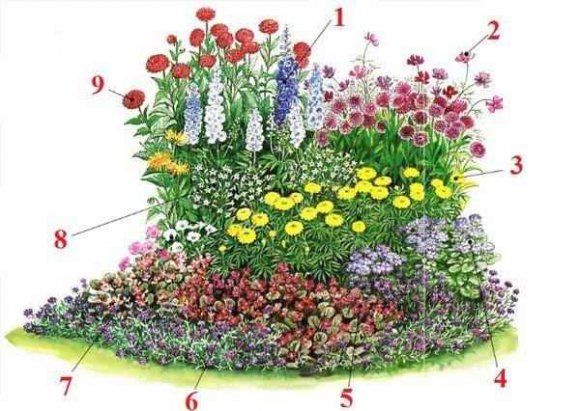
No. 1 "Delphinium". Perhaps the most popular flower in mixborders. (perennial)
No. 2 "Cosmos double-feathered". Tall openwork plant is characterized by abundant flowering, but, according to some gardeners, it does not look very sophisticated. (annual)
No. 3 "Tagetes erect". Powerful plants, reaching 50-100 cm in height, have amazingly beautiful semi-double inflorescences of orange, light yellow or bright yellow. (annual)
No. 4 Houston Ageratum. Violet-pink, white and bright blue baskets of inflorescences-baskets of this plant deserve to grow in the most prominent place of the mixborder. (annual)
№5 "Everblooming Begonia". In a flower mixborder, this semi-shrub is good for its large, smooth, wide leaves, and loose inflorescences of the most tempting flowers. (annual)
No. 6 "Verbena". For all its unpretentiousness, verbena is able to delight with elegant inflorescences from summer to September. (annual)
No. 7 "Petunia". In the photo of mixborders, you can often see flowers of all shades of the rainbow - petunias. Fragrant cascades of delicate flowers adorn the plant from June until the first frost. (an annual, which, if desired, can always become an annual)
No. 8 "Tobacco Sander". Large, odorless flowers remain open only during the day. (one-year-olds)
No. 9 "Dahlia". A majestic flower with terry petals looks great both from afar and close. Blooms profusely in full sun with sufficient moisture.
A gardener who designs a mixborder is akin to an artist painting a picture. Using varieties of different plants and flowers, he creates a solemnly bright or, conversely, a pacifying and calm flower garden, which, with the end of summer, does not lose its colors, but simply acquires new ones.
Coniferous mixborder - scheme
Spectacular horizontals and verticals of coniferous trees and shrubs, the cutting of which further emphasizes and enhances the contrast of plants in shape, help the coniferous mixborder to maintain its decorative effect 365 days a year.
Tall spruces and pines are hardly suitable for planting in mixborders. But small specimens of conifers, such as dwarf varieties of spruces, firs, pines, as well as compact arborvitae and junipers, will be very useful.
To give a large composition of conifers and shrubs rhythm, its elements must be repeated 3-5 times.
A coniferous mixborder in a garden or on a country plot will not be boring and ascetic if its design is complemented with beautiful heather and flowering perennials.
The device of a tiered flower garden of continuous flowering
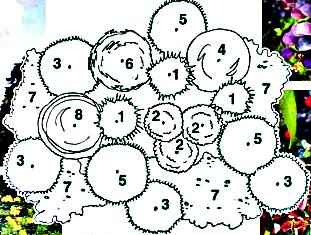
No. 1 Pine "Fastigiata". When a narrow vertical needs to be added to a landscape design project, blue pines of various sizes are chosen. (3 pcs.)
No. 2 "Rhododendron". This mixborder scheme uses evergreen shrubs with yellow flowers. Rhododendrons bloom in late summer or early June. Not long, but incredibly beautiful. (3 pcs.)
No. 3 Pine "Pumilo". This prostrate coniferous shrub always has a place in the garden landscape. (4 things.)
No. 4 Deren "Elegatissima". Flowers on the crown of this deciduous shrub appear in May. The remaining days of the year, derens are decorated with dark green leaves with a whitish border. (1 PC.)
No. 5 Pine "Mugus". An alpine tree-shrub does not need to be cut to be restrained in growth. But be sure to plant in a sunny place - in the shade the plant will quickly die. (3 pcs.)
№6 Barberry Ottawa "Superba". A beautiful shrub with dark purple leaves blooms in May, and with the advent of autumn, it changes its “dress” to a “coat” of lingonberry-purple tones. (1 PC)
No. 7 "Cotoneaster horizontal". This creeping shrub is good for decorating walls, garden elements and spaces between large plants. (5 pieces.)
No. 8 Deren "Sibirika Variegata". The rounded crown of an ornamental shrub with a rich red color of the bark goes well with coniferous and woody plants. (1 PC.)
When composing mixborder compositions on your own, you need to understand that there are slow-growing and fast-growing plants. If you are not ready to wait for the plants (in our case, shrubs) to grow, you will have to immediately purchase large specimens.
Mixborders - photos of the most beautiful flower beds
Do you still doubt that mixborders in the garden are the most popular and spectacular landscaping technique? Then check out the blooming arrangements that look great on both sides.
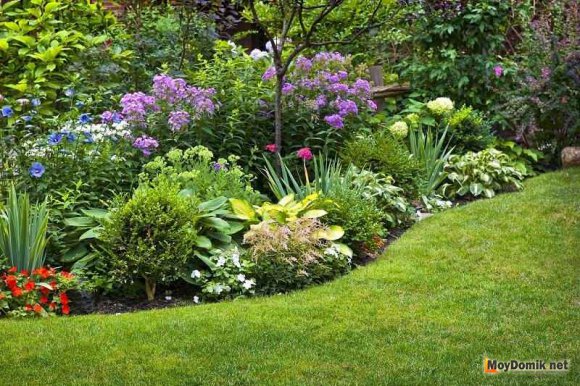



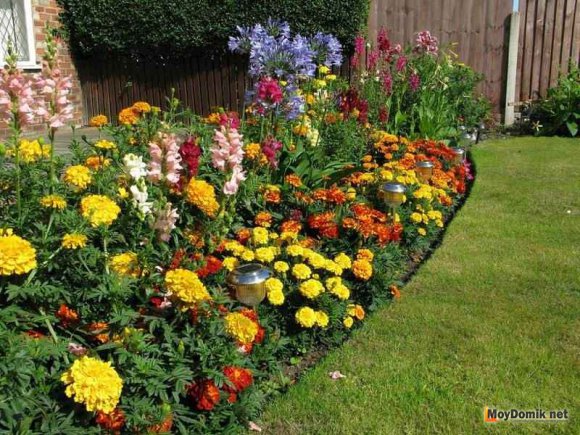
![]()
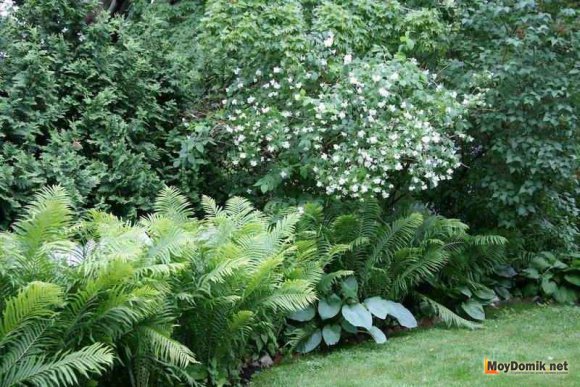
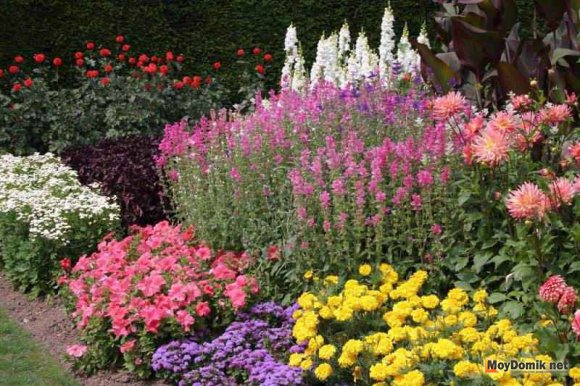

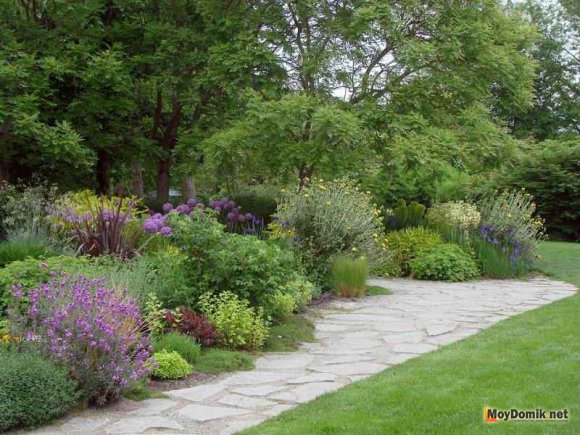

Group compositions, large and small ensembles are the basis of landscaping a garden. And if the combination of perennials and annuals creates a motley carpet in flower beds, in which color schemes and the general appearance of the flower bed are more important than the combination of individual neighbors, then for a group of trees and shrubs, the quality and correct selection of plants is a decisive factor that determines the decorativeness of the entire ensemble. Only those groups will look advantageous, especially when it comes to small compositions that are built on spectacular contrasts, while opposite, dissimilar should be not only the height and size, but also the shape of the foliage, the color of the crown, the degree of its density. Such contrasts are called complex, because they take into account the entire spectrum of plant characteristics. At the same time, one should not be afraid to “combine the incompatible”: deciduous and coniferous, flowering and decorative-deciduous, evergreen and large-leaved plants can and should be mixed with each other, because it is on such a combination that the most beautiful contrasts are built.
The best combinations of plants, the most fashionable combinations of trees and shrubs include the play of green and white in a combination of catalpa, spruce, hydrangea and derain; a vibrant trio of Japanese maple, azalea and fan maple; a spectacular small quartet of euonymus, azalea, rhododendron and Japanese maple; tree row of pyramidal hornbeam, yew berry, globular maple and decorative plum; a tall duet of sharp-leaved maple and whole-leaved willow, as well as a multi-tiered ensemble of spruce, cedar and magnolias. Let's take a closer look at the 6 most spectacular ensembles built on complex contrast.
In a combination of derain, hydrangeas, catalpas and spruce, everything “plays” on combinations of shapes, crown density and colors. The dynamic composition is contrasting in all possible parameters, most widely representing the diversity of trees and shrubs. The magnificent spherical crown of the classic bignonian catalpa consists of densely spaced large leaves, creating a very rich green crown. In contrast to it, lush-colored tree-like hydrangeas with incredible caps of pastel shades play, which can be placed in the near-trunk circle. As a contrast to the lower hydrangea and a counterbalance to the high catalpa, the ensemble features a high, controversial turf with a loose, airy, uneven crown, the branches of which are arranged in tiers, and the greenery is colored in mottled white-green or unusual green, not at all like a catalpa shade. As a balancing element in this quartet, a creeping dwarf spruce with a lush, squat needle-like crown and an unusual muted dark coniferous color is introduced into this quartet. You can diversify such a quartet by introducing sheared conifers with a pyramidal or conical crown, flowering shrubs with arcuate branches. For small gardens, catalpa and deren, exceeding 4 meters in height, should be replaced with other deciduous trees with a loose crown and standard form up to 2 - 3 meters in height.
The trio of Japanese and fan maples and azaleas (rhododendrons) is built on a spectacular play of color, but these plants are also contrasting in terms of the type of greenery, growth, crown shape and decorative qualities. Tall, with a multi-tiered crown Shirasawa maple - a spectacular species of the genus Maple with a bright crown and a golden hue of light green color grows only a little over 3 meters in height. It goes well with another type of maple - fan, planted in the foreground, which is characterized by red leaves and decorative branches with different shades of varieties and shorter growth. Two imposing representatives of woody plants do not lose their beauty from early spring until late autumn, and their beautiful branches are good against the backdrop of snowdrifts. Both of these plants will happily settle in places with acidic and moist soil, which is required by the lower Japanese azalea, which today is more correctly called rhododendron. The dazzling massive flowering of a densely branched plant is perfectly set off by the decorative foliage of maples. This ensemble is most spectacular in spring, when azaleas bloom. You can replace such a trio with the union of silver sucker, spirea and ornamental apple trees (or wild lemon).
A composition of Japanese maple, Yakushiman rhododendron, lower varietal rhododendron (azalea) and compact euonymus will not take up much space and will fit even in the smallest garden, while almost all plants (except maple) will not lose their decorative effect in winter. The golden-leaved Japanese euonymus, only one and a half meters high, will perfectly set off the ensemble in the background, giving the foreground to an elegant dwarf variety of Japanese maple with filigree leaves, the color of which varies depending on the variety, and undersized rhododendrons, more similar to those planted in open ground houseplants. Above an azalea or dwarf rhododendron, for contrast, it is better to plant one of the most impressive species of this plant - the yakushiman rhododendron, while the brighter the color of its flowers, the better. Such an ensemble is the best suited for compositions in the middle of the lawn, because it is perfectly combined and combined with decorative deciduous perennials, for example, geyhera, with which you can create a spectacular transition. Rhododendrons can be replaced with a combination of dwarf pine or any other evergreen plant with lilac, action, kerria in the background.
Creating a scene from trees is quite simple, but one should take into account their growth and size after decades. A row of trees along the perimeter of the site will also look more impressive if it is planted from different plants that contrast in shape and type. So, a slender row of a pyramidal crown of common hornbeam, a spherical crown of Norway maple, a loose crown of decorative finely serrated cherry and a slender yew berry will acquire full “sound” only after 10, or even all 20 - 30 years after planting, turning into a magnificent wall of huge contrasting forms. Slow growing trees can be planted at the border of even small gardens. Such a row can be made up of any favorite trees, the main thing is to combine cultures with different crowns - loose, dense, evergreen, pyramidal, spherical, etc.
If you are looking for trees for a front garden in which large crops are unlikely to fit, pay attention to the contrasting and spectacular duet of massive Norway maple (low varieties) and the elegant, airy-shallow crown of willow. They will stay compact with regular pruning, and the sides of the track will create an amazing play of hues and textures. The same rule should be followed when choosing shrubs: for each selected plant, find a pair that is completely different from it in terms of greenery, crown density, and try to place contrasting plants symmetrically in different parts of the front garden.
Those who are lucky enough to become the owner of large gardens should boldly combine plants in multi-tiered compositions, because in such areas you can afford to plant even the largest trees, surrounding them with a delightful play of opposite shapes and colors. One of the best compositions, striking in its proud showiness, is a combination of a tall spruce with sprawling branches of a powerful and contrasting cedar and picturesque magnolias planted in the foreground with incredible beauty of intricately curving branches, graceful flowers and greenery gathered in bunches. You can complete this trio with undersized shrubs with beautiful flowering - for example, rhododendrons. The composition of spruce or pine, hybrid horse chestnut, beaver or skumpia and any traditional flowering shrub, such as mock orange, lilac or American jamsia, also looks no less impressive.



